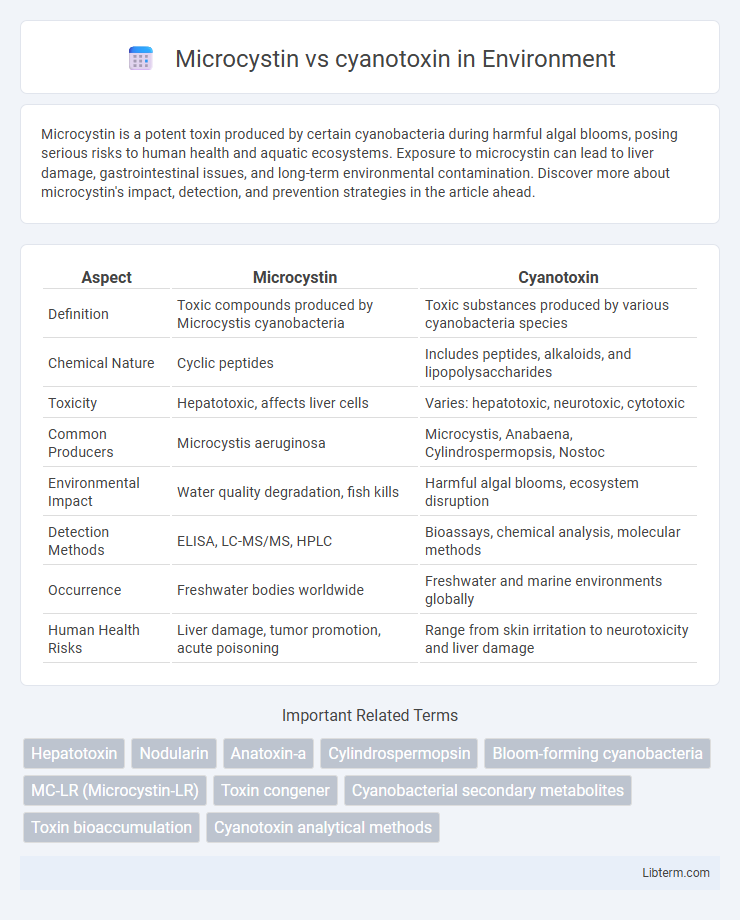Microcystin is a potent toxin produced by certain cyanobacteria during harmful algal blooms, posing serious risks to human health and aquatic ecosystems. Exposure to microcystin can lead to liver damage, gastrointestinal issues, and long-term environmental contamination. Discover more about microcystin's impact, detection, and prevention strategies in the article ahead.
Table of Comparison
| Aspect | Microcystin | Cyanotoxin |
|---|---|---|
| Definition | Toxic compounds produced by Microcystis cyanobacteria | Toxic substances produced by various cyanobacteria species |
| Chemical Nature | Cyclic peptides | Includes peptides, alkaloids, and lipopolysaccharides |
| Toxicity | Hepatotoxic, affects liver cells | Varies: hepatotoxic, neurotoxic, cytotoxic |
| Common Producers | Microcystis aeruginosa | Microcystis, Anabaena, Cylindrospermopsis, Nostoc |
| Environmental Impact | Water quality degradation, fish kills | Harmful algal blooms, ecosystem disruption |
| Detection Methods | ELISA, LC-MS/MS, HPLC | Bioassays, chemical analysis, molecular methods |
| Occurrence | Freshwater bodies worldwide | Freshwater and marine environments globally |
| Human Health Risks | Liver damage, tumor promotion, acute poisoning | Range from skin irritation to neurotoxicity and liver damage |
Introduction to Microcystin and Cyanotoxin
Microcystins are a class of cyanotoxins produced predominantly by certain strains of freshwater cyanobacteria such as Microcystis aeruginosa. Cyanotoxins encompass a broad group of toxic compounds, including microcystins, anatoxins, cylindrospermopsins, and saxitoxins, produced by various cyanobacterial species during harmful algal blooms. Microcystins are notable for their hepatotoxic effects, often contaminating water supplies and posing significant risks to human and animal health.
Defining Microcystin: Structure and Origins
Microcystin is a potent cyanotoxin produced by certain strains of freshwater cyanobacteria, primarily Microcystis species. Structurally, microcystins are cyclic heptapeptides characterized by the presence of the unique amino acid Adda, which is critical for their toxicity. These toxins originate from harmful algal blooms in nutrient-rich aquatic environments, posing risks to ecosystems and human health through liver damage upon ingestion.
What Are Cyanotoxins? Overview and Classification
Cyanotoxins are a diverse group of toxic compounds produced by cyanobacteria, commonly known as blue-green algae, which can contaminate water bodies and pose health risks to humans and animals. These toxins are classified into several major categories based on their chemical structure and mode of action, including hepatotoxins (such as Microcystins), neurotoxins, cytotoxins, and dermatotoxins. Microcystins constitute the most studied class of cyanotoxins, primarily targeting the liver and causing potential liver damage, making them a critical concern for water quality monitoring and management.
Key Differences: Microcystin vs. Other Cyanotoxins
Microcystin is a specific type of cyanotoxin produced primarily by Microcystis species, known for its potent hepatotoxic effects that target the liver. Other cyanotoxins, such as anatoxin-a and cylindrospermopsin, differ in their chemical structure and toxicological impact, affecting the nervous system and multiple organs respectively. Microcystin's unique microcystin-LR variant is often used as a reference for toxicity due to its high frequency and severe environmental impact compared to other cyanotoxins.
Sources and Environmental Occurrence
Microcystins are a specific group of cyanotoxins produced primarily by freshwater cyanobacteria such as Microcystis aeruginosa, commonly found in nutrient-rich lakes and reservoirs. Cyanotoxins encompass a broader category of toxins produced by various cyanobacterial genera including Anabaena, Planktothrix, and Cylindrospermopsis, occurring in diverse aquatic environments ranging from freshwater to brackish ecosystems. The environmental occurrence of microcystins is often linked to eutrophication and warm temperatures promoting cyanobacterial blooms, making them prevalent indicators of freshwater contamination and public health risk.
Health Impacts: Microcystin Compared to Other Cyanotoxins
Microcystin, a potent cyanotoxin produced primarily by Microcystis species, poses significant health risks including liver damage and toxicity, often exceeding the severity of other common cyanotoxins like anatoxin-a and cylindrospermopsin. Exposure to microcystin-contaminated water can result in acute symptoms such as nausea, vomiting, and abdominal pain, alongside chronic effects including liver tumor promotion and immunotoxicity. Compared to other cyanotoxins, microcystin's persistence and bioaccumulation in aquatic environments make it a critical concern for public health, necessitating rigorous monitoring and control measures.
Detection and Monitoring Methods
Microcystins, a subset of cyanotoxins produced primarily by Microcystis species, require sensitive detection methods such as ELISA and LC-MS/MS to quantify their presence in water samples accurately. Cyanotoxin monitoring extends beyond microcystins to include anatoxins and cylindrospermopsins, employing molecular techniques like qPCR to detect toxin-producing genes and bioassays for toxicity assessment. Continuous in situ sensors and remote sensing technologies enhance real-time surveillance, facilitating early warning systems for water quality management and public health protection.
Regulation and Safety Standards
Microcystin, a potent cyanotoxin produced by certain cyanobacteria, is regulated under various water quality standards due to its hepatotoxic effects. The World Health Organization (WHO) sets a provisional guideline value of 1 ug/L for microcystin-LR in drinking water, while the Environmental Protection Agency (EPA) has established health advisories to manage exposure risks. Regulatory frameworks emphasize routine monitoring and risk assessment to ensure safety in recreational waters and public drinking supplies, reflecting the global priority of controlling cyanotoxin contamination.
Prevention and Mitigation Strategies
Microcystins, a subgroup of cyanotoxins produced by Microcystis algae, require targeted prevention strategies such as limiting nutrient runoff and controlling algal bloom formation. Effective mitigation involves advanced water treatment methods like activated carbon filtration and ozonation to remove toxins from drinking water. Monitoring programs utilizing remote sensing and in-situ toxin detection technologies enhance early warning systems to reduce human and ecological exposure risks.
Future Research and Ongoing Challenges
Future research on microcystin, a specific cyanotoxin produced by Microcystis aeruginosa, focuses on understanding its molecular mechanisms of toxicity and developing advanced detection methods. Ongoing challenges include mitigating microcystin contamination in freshwater systems amid climate change-driven cyanobacterial blooms and improving water treatment technologies to effectively remove diverse cyanotoxins. Integration of omics technologies and machine learning models aims to predict cyanotoxin occurrences, enhancing public health protection and environmental monitoring.
Microcystin Infographic

 libterm.com
libterm.com